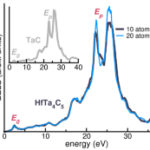2022-12-25 英国・ケンブリッジ大学

・ ケンブリッジ大学、オーストリア科学アカデミー(OeAW)およびレオーベン鉱山業大学が、高性能磁石のテトラテーナイトを合成する新技術を実証。
・ 高性能磁石は、ゼロカーボン経済の確立において不可欠な技術。現在最も高性能の永久磁石では希土類元素を利用しているが、世界の希土類生産を中国がほぼ独占している(2017 年では 81%)。
・ オーストラリアでも採掘されているが、中国との地政学的な緊張が高まる中、供給リスクが懸念される。また、極めて破壊的な採掘プロセスを通じた大量採掘に対し、得られる希土類は少量に限られる。
環境への影響と中国への依存への対処において、希土類が不要な代替材料の開発が急がれる。
・ 鉄とニッケルの合金で規則的な結晶構造を持つ「コズミックマグネット」のテトラテーナイトは、希土類による磁石の代替が期待できる材料の一つ。天然の隕石が徐々に冷えることで鉄とニッケルの原子が特定の順序に積層して形成され、希土類の磁石に匹敵する磁気特性を持つようになる。
・ 1960 年代に開発された、鉄-ニッケル合金に中性子を照射してその原子を規則的に配列させる方法は大量生産には適さず、それ以降に開発された技術も産業規模の作製レベルに達していない。
・ 本研究では、微量のリン(隕石にも含まれる元素)を含んだ鉄-ニッケル合金の機械特性の調査中に樹木の枝のようなデンドライト(樹状突起)構造を確認。リンが鉄とニッケルの原子を迅速に移動させ、数百年を待たずとも規則的な積層構造の形成を促すことを発見した。
・ 適切な分量の鉄、ニッケルとリンの混合により、テトラテーナイトの合成速度が 11~15 桁向上し、溶融して型に注ぎ込むシンプルなキャスティングで数秒内に完成する。隕石でのテトラテーナイトの形成に数百年間を要することの信憑性に疑問を投げかけざるを得ない研究結果となった。
・ ただし、高性能磁石としての適性の特定にはさらに研究を進める必要があるため、磁石メーカーとの共同研究を希望する。ケンブリッジ大学の商業化部門の Cambridge Enterprise と OeAW が本合成技術の特許を出願済み。
・ 本研究は、欧州連合(EU) Horizon 2020 研究・イノベーションプロブラム下、欧州研究会議(ERC)、第7 次欧州研究開発フレームワーク計画(FP7)およびオーストリア科学基金(FWF)が支援した。
URL: https://www.cam.ac.uk/research/news/new-approach-to-cosmic-magnet-manufacturing-could-reduce-reliance-on-rare-earths-in-low-carbon
<NEDO海外技術情報より>
関連情報
Advanced Science 掲載論文(フルテキスト)
Direct Formation of Hard-Magnetic Tetrataenite in Bulk Alloy Castings
URL: https://onlinelibrary.wiley.com/doi/10.1002/advs.202204315
Abstract
Currently, predominant high-performance permanent magnets contain rare-earth elements. In the search for rare-earth-free alternates, body-centered tetragonal Fe–Ni is notable. The ordering to form this phase from the usual cubic close-packed Fe-Ni is understood to be possible only below a critical temperature, commonly accepted to be 593 K. The ordering is first demonstrated by using neutron irradiation to accelerate atomic diffusion. The tetragonal phase, designated as the mineral tetrataenite, is found in Fe-based meteorites, its formation attributed to ultra-slow cooling. Despite many attempts with diverse approaches, bulk synthesis of tetrataenite has not been reported. Here it is shown that with appropriate alloy compositions, bulk synthesis of tetrataenite is possible, even in conventional casting at cooling rates 11‒15 orders of magnitude higher than in meteorites. The barrier to obtaining tetrataenite (slow ordering from cubic close-packed to body-centered tetragonal) is circumvented, opening a processing window for potential rare-earth-free permanent magnets. The formation of tetrataenite on industrially practicable timescales also throws into question the interpretation of its formation in meteorites and their associated cooling rates.



